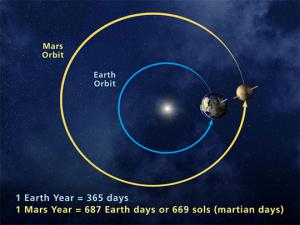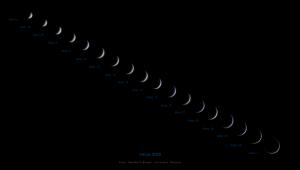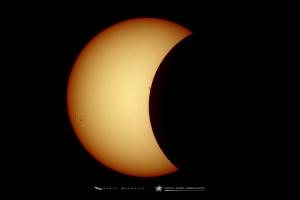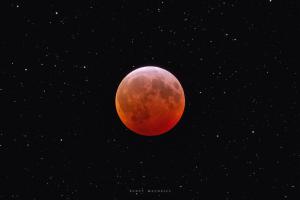Astronomical Highlights for 2021
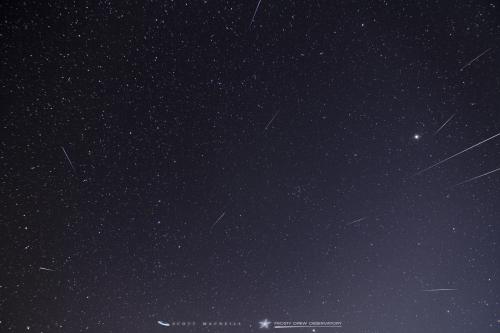
The Quandrantid Meteor Shower at Frosty Drew Observatory, by Frosty Drew Astronomy Team member Scott MacNeill
Happy New Year everyone. I can’t believe it is 2021! Happy 50th Anniversary to my fellow 1971 graduates of North Smithfield High School. Perhaps later this year we will be able to celebrate this milestone in our lives. For now, I will focus on some of the astronomical highlights for 2021. We are always at the mercy of the local Southern New England weather, but I hope when the skies are clear you will venture outdoors to experience a few of Mother Nature’s beautiful stargazing events.
We are fortunate the sky gods provide us northern hemisphere sky observers with a decent meteor shower to begin the new year. On the night of January 2-3, the peak of the Quadrantid meteor shower occurs. These fast-moving shooting stars blaze across the sky at 25.5 miles per second. Usually blue in color, the Quadrantids can appear anywhere in the sky, but their radiant point (the area of sky from where the meteors appear to originate) is not far from the end star, Alkaid, of the Big Dipper’s handle. From midnight till dawn, this area of sky will rise higher and higher above the northeast horizon. By 4:00 a.m. the radiant will be almost at zenith (directly overhead). You’ll know you’ve spotted a Quadrantid meteor if its dust train through the sky points back to the radiant point.
While the Quadrantid meteor shower can produce up to 100 meteors per hour during peak, a more modest 60 meteors per hour is likely under a moon-less sky. Unfortunately, a bright waning gibbous Moon (which was Full on December 30) will rise around 8:30 p.m. on the 2nd and will be in the sky almost all night. This circumstance will certainly reduce your meteor count. Keep in mind that this meteor display also sports a very narrow peak of activity, only several hours in duration, that can easily be missed.
Also, on the 2nd of January, the Earth is at perihelion — closest to the Sun for the year. Why then is this time of the year usually so cold for us in New England? The northern hemisphere where we are located is tilted away from the Sun as the Earth’s axis of rotation remains fixed in space in its solar orbit. Here’s a brief video refresher on this topic. Head to the southern hemisphere if you wish to bask in the more direct rays of sunshine.
For you early risers during the first week of January you can still spot brilliant Venus low in the southeast sky before sunrise. Venus will soon be unobservable as it moves closer to the Sun from our vantage point in space. Venus will return to the evening sky very low after sunset in the west-northwest during early June.
The solar system’s innermost planet, Mercury, can be seen only when it moves away from the Sun as seen from the Earth. We can observe Mercury in the eastern sky before sunrise, or in the western sky after sunset. These events are called elongations. Some elongations are better than others.
On January 24 Mercury will appear low in the southwest sky within 10 degrees of the horizon during late twilight. Another evening elongation occurs on the night of May 17 about 12 degrees above the north-northwest horizon during late twilight as well. For early risers there is a morning elongation on October 25 when Mercury will appear about 10 degrees above the east-southeast horizon. These dates will provide you the best opportunity to get a glimpse of this hellish world (unless you were fortunate to view its transit across the face of the Sun last November 11).
Do you remember where you stored your solar eclipse glasses after the August 21, 2017 eclipse? Well, I’m providing an advance notice for you to find them in preparation for the June 10 partial solar eclipse. This event will be somewhat unique in that the eclipse will already be in progress as the Sun rises that morning. You are going to need an unobstructed view of the northeast horizon to witness the onset of this event. The Sun will become visible peeking above the horizon around 5:15 a.m. When the Sun completely clears the horizon two minutes later 53% of the solar surface will already be covered by the Moon. Mid or maximum eclipse occurs at 5:32 a.m. when 72% of the solar surface will be obscured. After that time the Moon will move away from the Sun and the eclipse will end at 6:31a.m. From start to finish for us in Rhode Island the duration of this eclipse will be approximately one hour and 17 minutes. I will provide a more extensive article about the details, including cautions on how to observe it safely, in my June column.
In addition, there is another eclipse visible locally in 2021, but this time it is a partial lunar eclipse. Soon after midnight on the morning of November 19, the Full Beaver Moon will glide through the Earth’s dark umbral shadow. The eclipse will begin at 1:20 a.m. EST with the Moon high in the sky, 64 degrees above the southern horizon. Mid eclipse, or when the greatest amount of the lunar surface is immersed in the umbral shadow, occurs at 4:20 a.m. 97% of the lunar disk will be eclipsed. After that moment the Moon will begin to slide out of the Earth’s shadow. For us here, the Moon will set below the west-northwest horizon at 6:50 a.m. before the end of the eclipse. This eclipse will take place with the Moon within the constellation Taurus. Before the eclipse begins you may notice the Hyades and Pleiades star clusters above and to the left of the Moon. As the Full Moon’s brightness diminishes as it enters the Earth’s shadow, watch these star clusters emerge as if someone were varying a dimmer switch. I’ll provide more details in my November column.
I am slightly optimistic that later this year the local observatories will be able to resume public observing sessions. Frosty Drew has remained open under strict Covid-19 mitigation protocols. See their website for details. Regardless, while the other observatories remain closed, do visit their respective websites for a wealth of astronomical information.
• Seagrave Memorial Observatory
• Ladd Observatory
• Margaret M. Jacoby Observatory
• Frosty Drew Observatory
Some of the topics highlighted in this column may be covered in depth as an event date approaches.
Please clip and save the following chart showing the observing prospects for the 2021 meteor showers. These displays of shooting stars only require your eyes, dark skies, and patience to enjoy.

Keep your eyes to the skies for 2021 and always.
Before you know it, I will be writing my highlights column for 2022!!
Be safe and remain healthy.
David A. Huestis
- Author:
- David Huestis
- Entry Date:
- Jan 2, 2021
- Published Under:
- David Huestis's Columns

